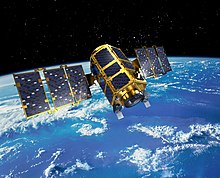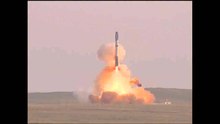KOMPSat
KOMPSat , an acronym for Ko rea M ulti- P urpose Sat ellite , is the name of a South Korean satellite series. The program began in 1994 to develop remote sensing technology in Korea.
Satellites
KOMPSat 1 (also Arirang-1) took off on December 21, 1999 from the Vandenberg launch complex 576E with a Taurus rocket in a 690 × 722 km high sun-synchronous orbit with an inclination of 98.3 °. The 470 kg satellite observed the world's oceans in the visible and near infrared range. The electro-optical camera (EOC) had a resolution of around 6.6 m and a swath width of 24 km. He also had particle detectors on board. It was developed by the Korea Aerospace Research Institute (KARI) on the basis of the Northrop-Grumman-Space-Technology-TRW- Lightsat-T200B - satellite bus for satellites weighing around 500 kg and with 73 kg hydrazinebuilt as fuel. TRW won the $ 32 million development contract on September 19, 1994.
On July 28, 2006, a Russian Rockot rocket launched from Plesetsk from the 800 kg satellite KOMPSat 2, also known as Arirang-2 , into a 685 km high sun-synchronous orbit . The launch was actually planned for 2004, but had been postponed due to problems with the launcher. The satellite carries a multispectral camera as its payload with a black and white spatial resolution of approx. One meter and a resolution of 4 m on 4 color channels in the range from 450 to 900 nm. The swath width is around 15 km, with the satellite taking 30 ° of the vertical can accommodate. The data is saved on a solid-state recorder. The service life was designed for three years. The total cost of the satellite system is estimated at $ 270 million.
KOMPSat 3 (Arirang-3), which has a similar structure to KOMPSat 2, was launched on May 17th, 2012 (May 18th local time) with a Japanese H-II A launcher.
The KOMPSat 5 satellite is equipped with radar (X-band SAR) instead of optical imaging technology. After the launch was only planned for 2012, the Korean Education and Science Minister Lee Ju-ho was informed in the spring of 2013 that the Dnepr program would be ended and that Korea would have to find an alternative to transport with this rocket. Nevertheless, a Dnepr missile was later made available, which was built in 1994 as an RS-20 ICBM and converted for space launches in 2009. The launch took place on August 22, 2013 from the Jasny Cosmodrome .
The start of KOMPSat 6 and KOMPSat 7 is planned for the end of 2021.
The satellite images are marketed by the Spot Image Group , provided they do not show any part of Korea.
Web links
- ESA eoPortal: KOMPSAT-1 , KOMPSAT-2 , KOMPSAT-3 , KOMPSAT-5 , KOMPSAT-6 , (English)
- Gunter's Space Page: KOMPSat 1 (Arirang 1) , KOMPSat 2 (Arirang 2) , KOMPSat 3, 3A (Arirang 3, 3A) , KOMPSat 5 (Arirang 5) , KOMPSAT 6 (Arirang 6) , KOMPSAT 7 (Arirang 7) ( English)
Individual evidence
- ↑ KARI website (no longer available)
- ↑ Günther Glatzel: H-2A starts satellite quartet. raumfahrer.net, May 17, 2012, accessed on May 17, 2012 .
- ↑ Anatoly Zak, George H. Chambers, S. Günes: Space exploration in 2013 , russianspaceweb.com, as of February 18, 2013, accessed on February 22, 2013
- ↑ Russian ICBM brings South Korean satellite safely into space. In: sputniknews.com. RIA Novosti, August 22, 2012, accessed August 23, 2012 .
- ↑ Arian Space: Arianespace to launch KOMPSAT-7 for the Korea Aerospace Research Institute (KARI) using a C Vega launch vehicle. September 20, 2018, accessed September 20, 2018 .
- ↑ Первый коммерческий запуск ракеты "Ангара" перенесли на конец 2021 года. TASS, February 12, 2020, accessed February 12, 2020 (Russian).

